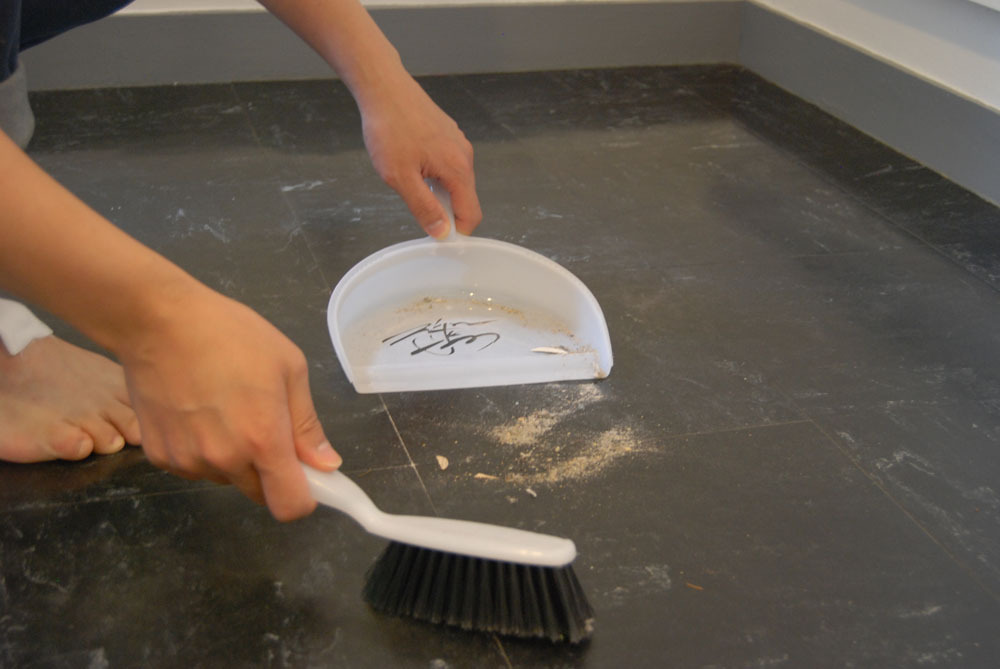In many works, pairing is used as both a compositional device and as a metaphor for intimate relationship. For Chair Chair Egg (2017), a tubular steel cantilever chair is stacked on an armless straight-back wooden chair. The mismatched chairs are wobbly when stacked, and one egg has been placed beneath a chair leg—a wonderful enactment of coupling as a precarious balancing act.
An evocative approach to work and authorship is Signature (2013). After a year in residency at Cité Internationale des Arts, Paris, the artists swept their studio before departure, using a dustpan into which RohwaJeong’s signature had been cut. The dustpan functioned as a stencil and produced a signature written in dust. As the artists stated in an interview conducted over email, “We left our signature in the atelier with a sweep of the floor. The studio’s dust contained our lives during the one year in residency. Signature speaks to time and the artist’s existence.”
RohwaJeong’s works use everyday materials and evoke the most ordinary of domestic activities as well as the play of children. In Play in the Frame—both a site-specific installation and a video—a wall of cement bricks appears to have been sealed with cake icing instead of mortar. Each brick was embellished using a different technique of cake decoration, with white cement used as “icing,” but the elaborate rosettes and garlands of each brick are flattened by the next brick layer.
RohwaJeong’s brick-and-icing wall was the title piece of Play in the Frame, a 2016 solo exhibition at Amado Art Space/Lab in Seoul. Across the two floors of the gallery space, various projects, some site-specific, explored notions of both play and frame. In one room, gold squares are arranged on the floor and walls, like a broken attempt at building a game board. The squares are made of caramelized sugar—a popular snack among school children. Eventually the squares, melting, will soften and change form. According to the artists, this work reflects their preoccupation with the rigidity of South Korean education, a system with few outlets for creative play: “Children are locked into a ‘frame’ that disregards our individuality, different surroundings, and experience.”
The student practice of marking key passages in a text is the starting point for Framed Play (2016). The first page of Virginia Woolf’s To the Lighthouse is reproduced on a wall. One passage—a description of a six-year-old’s sensations as he plays—is highlighted. In a wry slowing down of the practice of swiping a marker under sentences, the artists have remade each letter with a Play-doh stamp. The colorful Play-doh letters match Woolf’s description of the boy’s imaginary world as he cuts out images from a catalogue: “The wheelbarrow, the lawn mower, the sound of poplar trees, leaves whitening before rain, rooks cawing, brooms knocking, dresses rustling—all these were so coloured and distinguished in his mind that he had already his private code, his secret language.”
RohwaJeong’s gestures are quiet and often ephemeral—a momentary framing or intervention that redirects attention. A brick wall from which buttercream frosting appears to ooze. A room partially tiled with caramelized sugar. A mosquito net embroidered with the phrase “Still Life.” Cutting boards on which the word “aesthetic” appears to have been disassembled. This latter work is an artistic statement of sorts. The artists, in discovering the similar spellings of “aesthetic,” “ethic,” and “ethnic,” considered connections among these words. They explain: “We thought about how these connections relate to contemporary issues, such as the refugee crisis, the intervention of world powers in the affairs of weak states, Western-oriented theory, and the aesthetic of neoliberalism. We wanted to address these heavy discourses with light and trivial kitchenware. The connections also speak to our own experience, and the question of how we can deliver virtue (‘ethic’) through our art practice (‘aesthetic’) from the smallest continent of East Asia (‘ethnic’).”

